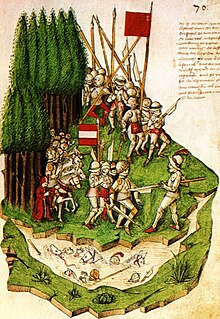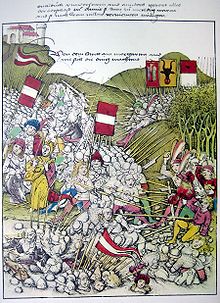Kuony von Stocken
Kuony von Stocken was a court jester of the Habsburg Duke Leopold I and is traditionally considered to be the originator of a custom still represented today in the Swabian-Alemannic Carnival .
Legend

According to the Tschachtlan Chronicle (1483), Leopold marched with his army to Ägeri ( Egre ) in the Morgarten War in 1315 and there discussed with his masters how the state of Schwyz could best be reached. It was decided to march across the Morgarten to Sattel .
Now Leopold turned to his fool, Kuony von Stocken ( Cuoni von Stocken ), and asked him how he liked the advice of the gentlemen. Kuony replied that he hated the advice. When the Duke then asks why, he answers
- Since hand ir all rats were in the country, but no one had rats against usz koment.

The figure of Kuony appears for the first time in 1415 in Heinrich Wittenwiler's poem The Ring . A little later, the story becomes an integral part of the story of the Morgarten War in the Swiss chronicles, including in the Bern Chronicle , the Tschachtlan Chronicle (1483) and the Spiezer Chronicle (1485). The illustrated chronicles depict Kuony as a figure with typical fool attributes in the midst of the turmoil, in the Spiez version as a fiddling violin player, in the Bern chronicle in the typical two-part fool's robe with donkey ears and bells.
Foolish court
After the crushing defeat of the Habsburgs in the Battle of Morgarten on November 15, 1315, in which the duke could not save much more than his life, the duke allegedly remembered the wise advice of his fool and granted him a wish. According to legend, Kuony asked for the privilege of holding a court in his hometown of Stockach every year, which much later became a court of fools.
Since Leopold died in 1326 and thus before the matter was settled, Kuony turned to Duke Albrecht the Wise , who is said to have granted him the privilege in 1351. Under the personal protection of the city lord of Stockach, Landgrave Eberhard von Nellenburg , Kuony is said to have finally brought the document to his hometown, where it was kept in the column of a fountain.
For the foundation of the jester's court, a document from 1743 is kept in Stockach, which is based on a template from 1687, which in turn refers to the alleged original privilege. This document found in the column of the central fountain says that Hans Kuene and all his descendants Burger von Stockhach, all year round. in the barrel night [...] the fool's court is forgiven u. be granted in grace. The language of the document refers to the 17th century.
The figure of Hans Kuony still plays a central role in today's Swabian-Alemannic Carnival . In the Stockach jester's court , which meets every year on Schmotzigen Thursday , he appears as an unmistakable fool in a black and red fool's costume. Based on his legend, his alleged hometown Stockach built a fountain for him, on which you can read all around his wise advice to the Duke of Habsburg.
Because of his advice to the Duke of Habsburg, Kuony von Stocken represents one of the two types of court jesters . While so-called natural fools such as Claus Narr with all sorts of ailments at the court of a prince amused him, but also the mortality of every human being and transience remembered all fame, Kuony stands as an artificial fool for a very intelligent person in truth, similar to Kunz von der Rosen , the court jester of Emperor Maximilian .
literature
- Journal of the Swabian Alemannic Fastnacht 2015: Narrenbote No. 38 dold.verlag 2014, ISBN 3-927-67784-1 , p. 36.
Web links
| personal data | |
|---|---|
| SURNAME | Kuony von Stocken |
| ALTERNATIVE NAMES | Hans Kuony |
| BRIEF DESCRIPTION | Court jester of the Austrian Duke Leopold I. |
| DATE OF BIRTH | 13th Century |
| DATE OF DEATH | 14th Century |